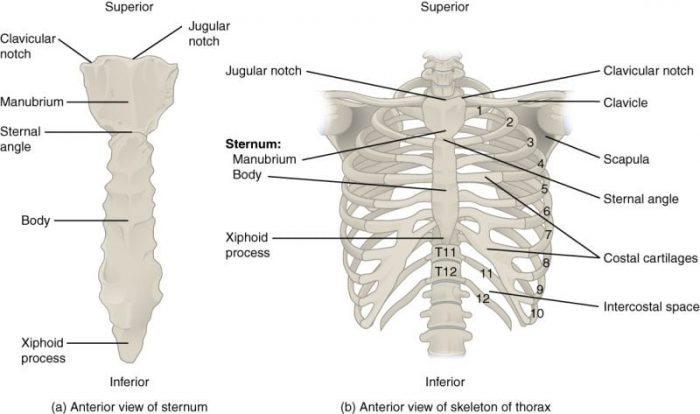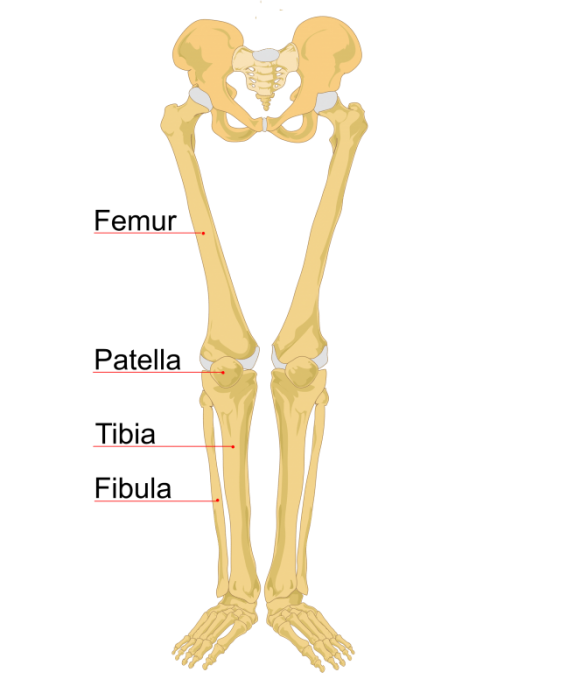
The labeled human skeleton system is comprised of 206 different bones of various sizes and shapes, all with the primary purpose of providing support, protection, and shape to the human body.
When humans are born we have close to 300 bones, and over time they fuse together. To learn all about the skeleton system in the human body, check out this guide.
I have found that, in the composition of the human body as compared with the bodies of animals, the organs of sense are duller and coarser. Thus, it is composed of less ingenious instruments, and of spaces less capacious for receiving the faculties of sense. – Leonardo da Vinci
Labeled Diagram Of The Human Skeleton
Here is an overview of the bones in the human body. This is not an in-depth view because there are so many smaller bones in the body, but these are the primary bones that you should know. Note the number of ribs and bones in the spinal column:
- There are 12 ribs in the human body
- There are 33 vertebrae in the human body
We will go more in-depth and list all the bones in the body. For now, however, let’s go over what our skeletal system does.
“If you cannot get rid of the family skeleton, you may as well make it dance.” — George Bernard Shaw
What Does The Human Skeletal System Do?
Like you might guess, our skeleton system is designed to help protect our organs, support our bodies, help with mobility, as well as act a storage system. Our skeleton system is what is called an endoskeleton, meaning our skeleton is inside the body. Some organisms, like insects and ocean animals, have an exoskeleton, meaning their skeleton system is outside of their body. There are even some animals who don’t have a skeleton, like a starfish, for example. Our skeletons also allow us to move because it is essentially a frame for muscles to attach to. Bones also supply red and white blood cells that are made in the bone marrow, which is the material inside the bone.
The Bones In The Human Body
Now let’s go over all the bones in the human body. We will start from the skull and work our way down.
Bones in the skull

The bones in the human skull. Image source: LadyofHat/Wikipedia, licensed under CC0
The bones of the skull can be broken down into 2 main parts: the cranial bones and the facial bones. In total there are 8 cranial bones and 14 facial bones comprising the 22 bones of the skull. Let’s go over those bones:
Cranial Bones
- Ethmoid bone
- Frontal bone
- Occipital bone
- Parietal bones (x2)
- Sphenoid bone
- Temporal bone (x2)
The cranial bones’ purpose is to protect our brain. There are very few holes in the bones, and those holes are for nerves and blood vessels to pass through. The occipital bone is where the spinal cord connects to our skull, and it also forms the first vertebrae of our spine.
Facial Bones
- Inferior Nasal Conchae
- Lacrimal Bones
- Mandible
- Maxillae (x2)
- The word maxilla is the singular form of maxillae
- Nasal Bones (x2)
- Palatine Bones (x2)
- Vomer
- Zygomatic Bones (x2)
The facial bones make up our face, obviously. Of all the 14 facial bones only one is mobile: the mandible, which is actually our jaw bone. Our upper teeth connect to the two maxillae while our lower teeth are connected to the mandible.
Bones in the spine

The vertebrae that comprise the spine. Notice there are 4 primary sections. Image source: CNX OpenStax/Wikimedia Commons, licensed under CC-BY 4.0
The human spine is broken down into 5 different regions; cervical, thoracic, lumbar, sacral, and the coccygeal region.
- Cervical region
- This has a total of 7 vertebrae and is the thinnest part of the spine
- Allows the neck to have mobility
- Thoracic region
- Consists of 12 vertebrae
- These vertebrae are stronger than the cervical vertebrae and they actually pair up with the ribs
- Lumbar region
- 5 vertebrae
- Stronger than the thoracic vertebrae and are very flexible
- Sacral region
- Contains the sacrum which is a bone that formed by a fusion of other bones (happens during adolescence)
- Located between the hipbones
- Coccygeal region
- The coccyx is located here which is a fusion of 4 vertebrae during adolescence
- Also called the tailbone
Bones in the abdomen and chest

Bones in the ribcage. Image source: Wikimedia Commons, OpenStax College licensed under CC-BY 3.0
Our abdomen consists of our ribcage and cartilage that surrounds and protects our organs.
Here are the bones found in our abdomen:
- The sternum which is comprised of the manubrium, body, and xiphoid process
- Ribs 1 to 12 are connected to the thoracic vertebrae
- Ribs 1 through 7 also consist of costal cartilage and are called “true ribs”
- Ribs 8 through 10 are called “false” ribs
- Ribs 11 and 12 are floating ribs
Bones of the arms

The bones of the arms. Image source: LadyofHats/Wikipedia licensed under CC0
The arms are made up of a multitude of different bones that allow for strength and mobility. These are 64 bones in our arms, shoulders, wrists, and hands:
- Humerus
- The shoulder consists of:
- scapula
- clavicles
- Ulna
- Radius
- The hands consist of (there are 54 bones in total):
- The carpals-
- scaphoid bone (x2)
- lunate bone (x2)
- triquetral bone (x2)
- pisiform bone (x2)
- trapezium (x2)
- trapezoid bone (x2)
- capitate bone (x2)
- hamate bone (x2)
- The metacarpals (10 total, 5 in each hand)
- The phalanges of the hand
- proximal phalanges
- intermediate phalanges
- distal phalanges
- The carpals-
Bones of the hips and legs

The major bones in the legs. Image by Jecwa/Wikimedia Commons licensed under CC0
The hip has three primary regions; the pubis, the ischium, and the ilium. The coccyx and sacrum are not included as part of the pelvic area because they serve a greater purpose for our spine.
The legs are comprised of the leg bones and the foot bones. The ankle area is very similar to the wrist in that it has a multitude of different bones. Here are the bones of the legs:
- The fibula (x2)
- The femur (x2)
- The patella (also known as the kneecap) (x2)
- The tibia (x2)
- The foot bones (52 total bones)
- The bones that make up the tarsus:
- Talus (x2)
- Heel bone (calcaneus) (x2)
- Medial cuneiform bone (x2)
- Intermediate cuneiform bone (x2)
- Lateral cuneiform bone (x2)
- Navicular bone (x2)
- Cuboid bone (x2)
- Metatarsals (10 total)
- The bones that make up the phalanges of the foot
- Proximal phalanges (10 total)
- Intermediate phalanges (8 total)
- Distal phalanges (10 total)
- The bones that make up the tarsus:









